| 编辑推荐: |
| 本文来自于简书,本文所讲的自动化测试UI
Automator最显著的特点就是,可以与多个app进行交互。 |
|
使用
首先我们在Android Studio中新建一个项目,取名为UIAutomatorTests。同时删除自动生成的一些文件,最终目录结构如下:
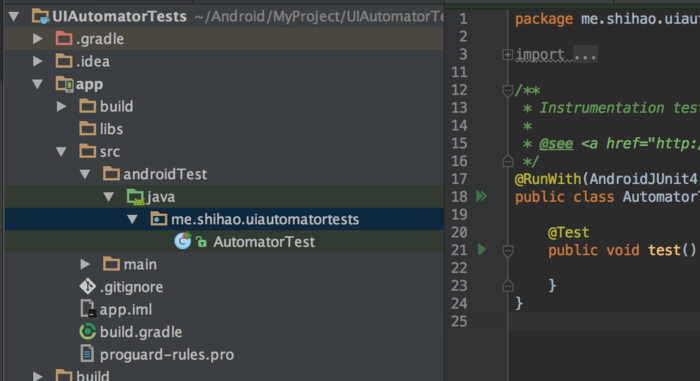
Paste_Image.png
接下来我们看看如何一步一步的使用Espresso,首先在根目录的 build.gradle 文件中添加下面的引入。
ext {
buildToolsVersion = "24.0.1"
supportLibVersion = "24.2.0"
uiautomatorVersion = "2.1.1"
runnerVersion = "0.5"
rulesVersion = "0.5"
}
|
在app目录中的build.gradle 文件中添加下面的引入,根据提示点击Sync Now。
dependencies
{
compile fileTree (dir: 'libs', include: ['*.jar'])
// App dependencies
compile 'com.android.support:appcompat-v7:' +
rootProject .supportLibVersion;
compile 'com.android .support:support-annotations
:' + rootProject .supportLibVersion;
androidTestCompile 'com .android.support :support-annotations
:' + rootProject .supportLibVersion;
androidTestCompile 'com .android .support .test
: runner :' + rootProject.runnerVersion ;
// UiA utomator Testing
androidTestCompile 'com .android .support .test
.uiautomator :uiautomator-v18:' + rootProject
.uiautomatorVersion ;
androidTestCompile 'org .hamcrest:hamcrest-integration
:1.3'
}
|
接下来我们在AutomatorTest.class中编写测试代码,为了测试多个app,这里我们选择上篇文章中的EspressoTests和手机中的设置app。
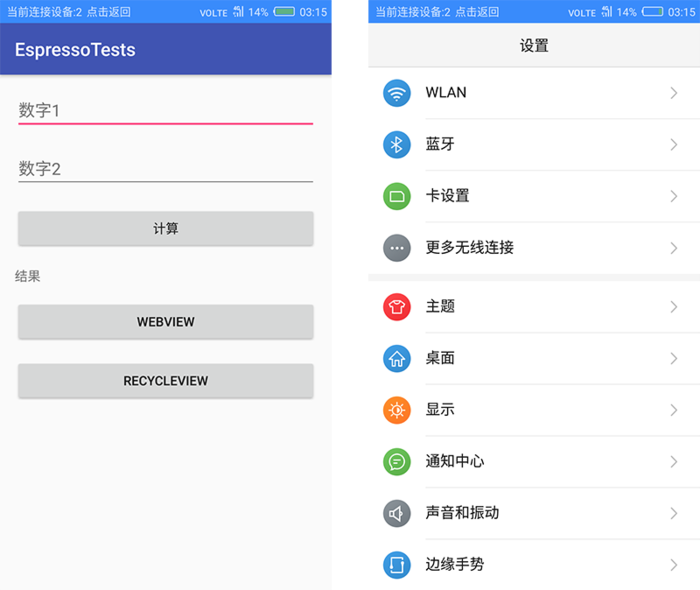
Paste_Image.png
在EspressoTests中我们输入数据点击计算,然后通过设置app为手机更换一个一个铃声。详细的测试代码如下:
package me.shihao
.uiautomatortests;
import android .content.Context;
import android .content.Intent;
import android .support.test.InstrumentationRegistry;
import android .support.test.filters.SdkSuppress;
import android .support.test.runner.AndroidJUnit4;
import android .support.test.uiautomator.By;
import android .support.test.uiautomator.UiDevice;
import android .support.test.uiautomator.UiObject;
import android .support.test.uiautomator.UiScrollable;
import android .support.test.uiautomator.UiSelector;
import android .support.test.uiautomator.Until;
import android .support.v7.widget.RecyclerView;
import android .widget.Button;
import android .widget.EditText;
import android .widget.ImageButton;
import android .widget.ListView;
import android .widget.ScrollView;
import android .widget.TextView;
import org.junit.Test;
import org.junit .runner.RunWith;
import static org .hamcrest.Matchers.notNullValue;
import static org .junit.Assert.*;
@RunWith (AndroidJUnit4.class)
@SdkSuppress (minSdkVersion = 18)
public class AutomatorTest {
private static final String PACKAGE_ESPRESSOTESTS
= "me .shihao .espressotests ";
private static final String PACKAGE_ SETTING =
"com.android.settings";
@Test
public void testEspressoTestsApp () throws Exception
{
// 初始化一个UiDevice对象
UiDevice mDevice = UiDevice.getInstance (InstrumentationRegistry
.getInstrumentation ());
// 点击home键,回到home界面
mDevice.pressHome();
String launcherPackage = mDevice .getLauncherPackageName
();
assertThat (launcherPackage, notNullValue());
mDevice .wait (Until.hasObject(By.pkg(launcherPackage).depth(0)),
3);
// 启动espressotests App
Context context = InstrumentationRegistry .getContext();
Intent intent = context .getPackageManager ()
.getLaunchIntentForPackage (PACKAGE_ESPRESSOTESTS)
;
// 清除以前的实例
intent.addFlags (Intent.FLAG_ACTIVITY_CLEAR_TASK);
context .startActivity (intent);
// 等待应用程序启动
mDevice.wait (Until.hasObject(By.pkg(PACKAGE_ESPRESSOTESTS).depth(0)),
3);
//通过id找到输入框一
UiObject edt1 = mDevice.findObject (new UiSelector
() .resourceId ("me.shihao .espressotests
:id/editText")
.className (EditText.class));
//往里面输入字符2
edt1.setText("2");
//通过id找到输入框二
UiObject edt2 = mDevice .findObject(new UiSelector
() .resourceId ("me.shihao .espressotests
:id/editText2")
.className ( EditText.class));
//往里面输入5
edt2.setText("5");
//通过文本"计算"找到按钮
UiObject btn = mDevice.findObject(new UiSelector().text("计算")
.className ( Button .class ) );
//执行点击事件,计算结果
btn.click ();
//通过id找到显示结果的 textview
UiObject tvResult = mDevice.findObject (new UiSelector()
.resourceId ( "me.shihao .espressotests:id/textView")
. className(TextView.class) );
//判断结果与预期是否匹配
assertEquals (tvResult.getText(), "计算结果:7");
//通过文本"RecycleView"找到按钮
UiObject btnRecycleView = mDevice .findObject
(new UiSelector() .text ("RecycleView")
.className(Button.class));
//执行点击事件跳转到另一个界面
btnRecycleView.click ();
//通过id找到recycleview
UiScrollable recycleview = new UiScrollable(new
UiSelector()
. className (RecyclerView.class)
. resourceId ("me.shihao.espressotests:id/recycleview"));
//滑动到底部
recycleview.flingForward();
//滑动到顶部
recycleview.flingBackward();
UiObject item5 = recycleview.getChild (new UiSelector().text("Item
5"));
//点击Item 5,然后会弹出一个对话框
item5.click();
//通过文本"确定"找到对话框中的确定按钮
UiObject btnConfirm = mDevice.findObject (new
UiSelector().text("确定") . className
(Button.class));
//点击确定关闭对话框
btnConfirm.click();
//另外一种方式找到Item 2
UiObject item = mDevice.findObject(new UiSelector()
. className (RecyclerView.class)
.resourceId ("me.shihao.espressotests:id/recycleview")
.childSelector (new UiSelector().text("Item
2") ) );
//点击弹出对话框
item.click();
//点击返回关闭对话框
mDevice.pressBack();
} @Test
public void testSettingApp() throws Exception
{
//初始化一个UiDevice对象
Context context = InstrumentationRegistry.getContext();
UiDevice mDevice = UiDevice.getInstance (InstrumentationRegistry
.getInstrumentation ());
//回到home界面
mDevice.pressHome();
// 启动设置
Intent intent = context.getPackageManager ().
getLaunchIntentForPackage ( PACKAGE_SETTING );
// 清除以前的实例
intent.addFlags(Intent.FLAG_ACTIVITY_CLEAR_TASK);
context. startActivity (intent);
//通过id找到scrollview
UiScrollable scrollview = new UiScrollable (new
UiSelector(). className (ScrollView.class) .resourceId("com"
+
".android .settings : id/dashboard")
);
//滑动到底部
scrollview.flingForward();
//通过文本找到关于手机
UiObject aboutPhone = scrollview.getChild (new
UiSelector().text("关于手机"));
//点击跳转到手机信息界面
aboutPhone.click();
//通过description找到向上返回的 ImageButton
UiObject ibtnBack = mDevice.findObject(new UiSelector().className
(ImageButton.class) .description("向上导航"));
//点击返回
ibtnBack.click();
//滑动到包含"提示音和通知"的地方
scrollview.scrollTextIntoView("提示音和通知");
//通过显示的文本找到控件
UiObject notify = scrollview.getChild (new UiSelector().text("提示音和通知"));
//点击跳转到下一个界面
notify.click();
//通过显示的文本"手机铃声"找到控件
UiObject sound = mDevice.findObject (new UiSelector().text("手机铃声"));
//点击跳转到铃声对话框
sound.click();
//通过id找到铃声列表
UiScrollable listview = new UiScrollable(new UiSelector().className
(ListView .class) .resourceId
(" android:id /select_dialog_listview")
);
//活动到包含"Beat Plucker"处
listview.scrollTextIntoView ( "Beat Plucker");
//通过显示的文本找到该项
UiObject beat = listview.getChild(new UiSelector().text("Beat
Plucker") );
//执行点击选中铃声
beat.click();
//通过文本"确定"找到对话框中的确定按钮
UiObject btnConfirm = mDevice.findObject(new UiSelector().text("确定")
. className (Button.class));
//点击确定关闭对话框
btnConfirm.click();
//通过id找到显示结果的TextView
UiObject tvSound = mDevice.findObject (new UiSelector()
.resourceId ("android : id/ summary"
).className(TextView
. class) );
//比较与预期结果是否一致
assertEquals(tvSound.getText(), "Beat Plucker");
//点击home键
mDevice.pressHome();
//点击最近应用键
mDevice.pressRecentApps();
//通过类名找到显示最近app的控件 TaskStackView
UiScrollable taskStackView = new UiScrollable
(new UiSelector(). className (" com.android
.systemui.recents.views" +
".TaskStackView") );
//滑动到包含"EspressoTests"处
taskStackView.scrollTextIntoView ("EspressoTests");
//通过显示的文本找到item
UiObject espressoTestsApp = taskStackView.getChild(new
UiSelector() .text (" EspressoTests")
);
//点击切换到前面的espressoTestsApp
espressoTestsApp .click();
}
}
|
运行效果如下:
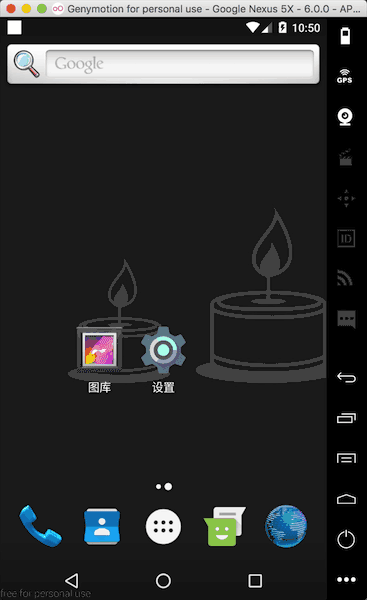
运行效果.gif
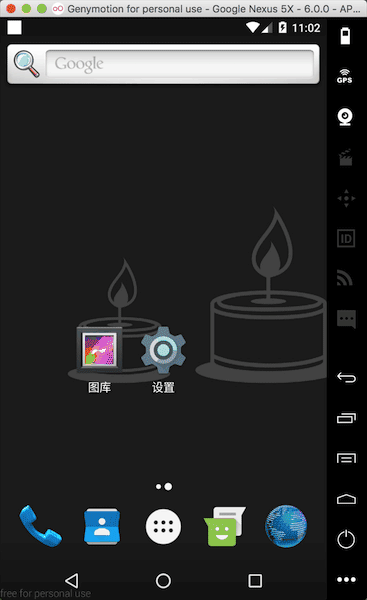
运行效果.gif
UI Automator Viewer使用
从上面的测试代码可以看到,我们需要首先知道目标控件的一些属性值,然后再围绕我们的目标属性构建一个匹配规则。而实际中我们并不知道app的实现,控件的属性并不是那么明显,或者并没有那么容易获取到,这时,我们可以使用Android提供的uiautomatorviewer工具帮助我们进行分析。
接下来我们就讲一下如何使用,Android Studio中点击Tools
>> Android >> Android Device Monitor
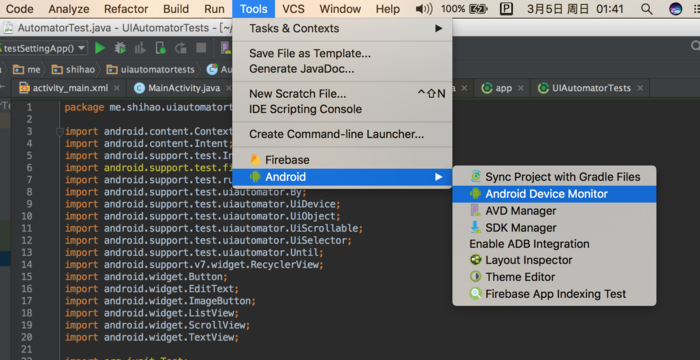
Paste_Image.png
下面显示的就是界面,最左边会显示连接的设备
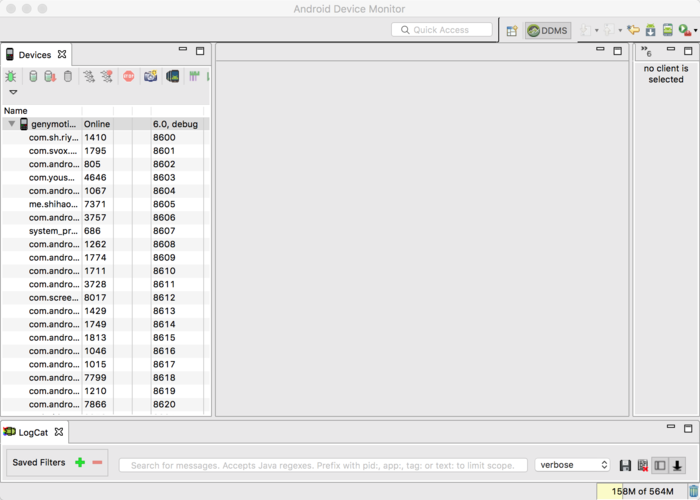
Paste_Image.png
点击会截图分析设备当前显示界面布局
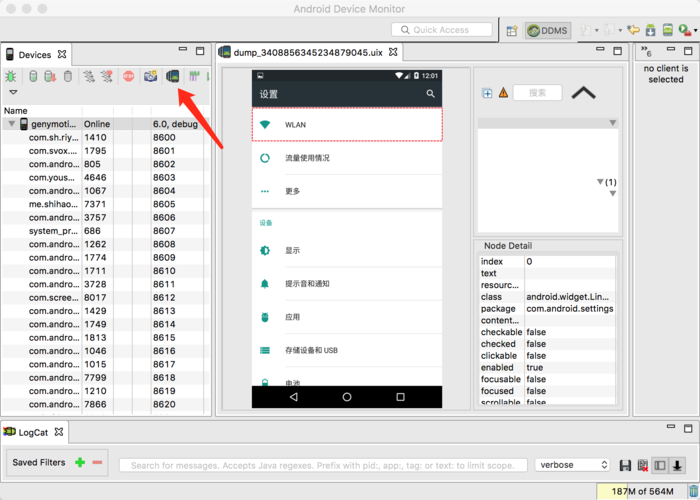
Paste_Image.png
然后右边会显示布局结构以及view详细的信息。
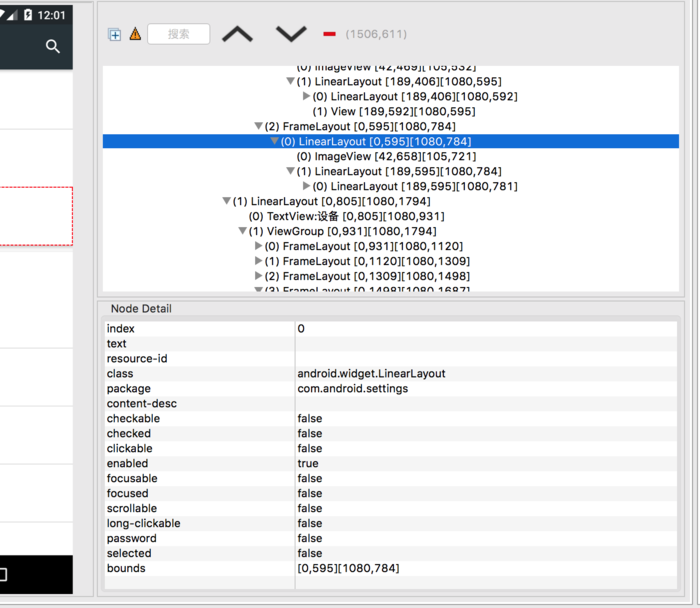
Paste_Image.png
|